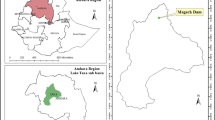Abstract
Magnesia Concrete is a kind of expansive concrete used in Chinese hydraulic engineering more and more widely. To evaluate the effects of autogenous expansion on the stresses of arch dams, a simple model of autogenous expansion for Magnesia Concrete in dam engineering is presented. This model is based on three assumptions: 1) the total amount of autogenous expansion of Magnesia Concrete is related only to the properties of materials and mixing of concrete; 2) the autogenous expansion of Magnesia Concrete is irreversible due to the irreversibility of hydration reaction of Magnesia in the concrete; 3) the autogenous expansion strain rates of Magnesia Concrete bear a relation between temperature and residual Magnesia per unit volume of concrete. The model is verified by some experimental data of autogenous expansion of Magnesia Concrete and field-measured data of an arch dam in China. Embedded into finite element arch dam simulation software, this model is employed to simulate the effects of autogenous expansion of Magnesia Concrete in hydraulic engineering.
Similar content being viewed by others
References
Stutterheim N. Properties and uses of high Magnesia Portland slag cement concretes. Journal of ACI, 1960, 56: 1027–1046
Satalkin A V, Komokhov P G, Kromin I P. Autoclave treatment of cement and Silicate-Matrix Concretes. Special Publication of ACI, 1972, 32: 141–148
Li Chengmu. Reviews on the applications of Magnesia Concrete in the dam engineering. Research on Hydropower Engineering, 1999, (2): 1–29 (in Chinese)
Jensen O M, Hansen P F. Autogenous deformation and in RH-change perspective. Cement and Concrete Research, 2001, 31(12): 1859–1865
Japan Concrete Institute. Technical Committee on Autogenous Shrinkage of Concrete. 1998
Serafim J L, Guerreiro M. Autogenous and hygrometric expansion of mass concrete. Journal of ACI, 1969, 66: 716–719
Houk I E, Jr, Borge O E, Houghton D L. Studies of autogenous volume change in concrete for Dworshak Dam. Journal of ACI, 1969, 66: 560–568
Li Penghui. Gentle expansion RCC and new structures of RCC arch dams. Dissertation for the Doctoral Degree. Beijing: Tsinghua University, 2000 (in Chinese)
Ulm F, Le Maou F, Boulav C. Creep and shrinkage of concrete-kinetics approach. Special Publication of ACI, 2000, 194: 135–154
Ishida T, Chuaube R P, Kishi T, Maekawa K. Micro-physical approach to coupled autogenous and drying shrinkage of concrete. In: Proceedings of the Sixth East Asia-Pacific Conference on Structural Engineering and Construction, EASEC-6.1998, 1905–1910
Liu Guangting, Mai Jiaxuan, Zhang Guoxin. Study on Xibing RCC thin arch dam. Journal of Hydroelectric Engineering, 1997, (2): 19–28 (in Chinese)
Author information
Authors and Affiliations
Corresponding author
Rights and permissions
About this article
Cite this article
Jin, F., Zhang, G., Luo, X. et al. Modelling autogenous expansion for magnesia concrete in arch dams. Front. Archit. Civ. Eng. China 2, 211–218 (2008). https://doi.org/10.1007/s11709-008-0025-7
Received:
Accepted:
Published:
Issue Date:
DOI: https://doi.org/10.1007/s11709-008-0025-7




